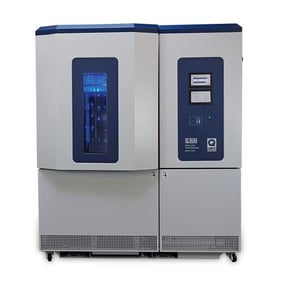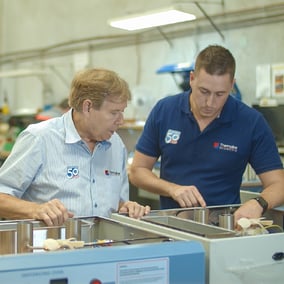ASTM B117, Standard Practice for Operating Salt Spray (FOG) Apparatus and ISO 9227, Corrosion tests in Artificial Atmospheres – Salt spray tests (specifically the Neutral Salt Spray test), are easily the most recognized test standards in the world for salt fog corrosion testing. These two standards are practiced internationally in numerous laboratories, with the ASTM standard having been used for over 100 years.
The language is very similar between the two test practices, with the ISO version using much of the same criteria from the older ASTM standard. The test conditions for both are a constant salt fog of 5% sodium chloride concentration at a chamber temperature of 35 °C. To ensure good reproducibility and repeatability, the standards also require regular reporting of fog collections, including the concentration of the collected solution. The ASTM practice requires daily reporting of these values, and no more than a 96 hour gap in reporting, which allows for a break during the weekend. The ISO standard does not specify a maximum lapse in reporting, and simply suggests that daily reporting is compulsory.
This blog will review the requirements of salt collections for the two standards and provide recommendations for meeting them in the laboratory. For the sake of simplicity, we will focus mainly on ASTM B117. Though there are minor differences between the two versions, they are essentially the same, and the requirements for collections and methods for measuring are similar.
What are the requirements?
The ASTM standard reviews the fog collection requirements with great detail, but there are two defining criteria for fog collections: deposition (volume, or “fallout”) and solution composition (pH and salt concentration).
The two criteria are assessed by evaluating the solution that deposits into collection vessels, typically a 100 mm diameter funnel placed on a graduated cylinder. This funnel size is referenced in the test standard and has become the industry standard. However, any size funnel may be used as long as it is properly included in the calculations. Though the standard only requires two collection vessels per atomizing spray nozzle, Q-Lab's recommendation is to use six. A picture of the 100 mm collection funnels on a graduated cylinder, as well as recommended vessel placements, are shown in Figure 1.

The fog deposition, or the amount of solution collected, is measured in a graduated cylinder. A continuous, uninterrupted fog test is conducted for a minimum of 16 hours for ASTM B117, and 24 hours for ISO 9227, with the collected fallout reported in ml/hr.
Both standards require a collection amount in the range of 1.0 – 2.0 ml/hr for each individual vessel. The salt concentration and pH of the solution must also be assessed. While users should measure the solution during preparation and mixing, the standard requires it to be measured from the collection vessels. There are two requirements for the solution. First, the solution must be neutral, with a pH of 6.5 - 7.2. And second, the concentration of the salt solution must be within 4.0 - 6.0%.
Adjusting Fog Deposition
Q-FOG chambers can easily reach the specified fog collection rate by using two mechanisms that provide independent control over Quantity and Uniformity. To adjust for the quantity, or collection volume, increase the pump speed.
The process is intuitive: an increase in pump speed will result in more solution introduced into the chamber, and an increase in the collection amounts. Conversely, a decrease in pump rate will decrease the collection amounts. To correct the uniformity, both the spray pressure and the nozzle alignment can be adjusted.
Increasing the spray pressure will result in a decrease in the collection amounts closest to the fog nozzle and an increase in collection amounts in the vessels furthest away (Figure 2, right). A decrease in the spray pressure will result in an inverse effect, increasing collection in the vessels closest to the nozzle and a decrease in vessels furthest away (Figure 2, left). While much of the uniformity can be accounted for by minor adjustments in the pressure, alignment of the fog nozzle may also be required.

Critically, each collection vessel only needs to be within the specified range, and there is no criteria for uniformity within either the ASTM or ISO standards. Technically a vessel could measure 1.0 ml/hr and another 2.0 ml/hr with the standard still being satisfied. As detailed in the previous paragraph, Q-FOG chambers are extremely reliable in setting up and producing uniform, typically with a minimum-maximum spread of 0.5 ml/hr, but a customer should not expect perfect uniformity between all collection vessels.
Measuring the pH and Concentration
The pH of the collected solution is required to fall within the range of 6.5 – 7.2, and is measured with a pH meter. The pH meter system must conform to ASTM E70, Standard Test Method for pH of Aqueous Solutions With the Glass Electrode. A buffering agent, such as hydrochloric acid or sodium hydroxide, may be required to adjust the pH accordingly. As outlined in the standard, measuring the concentration of the solution can be completed with several methods - specific gravity hydrometer, salimeter hydrometer, refractometer, and titration. The most popular method is using a specific gravity hydrometer. The principle of this device is centuries old, dating back to ancient Greek times, and is used to determine the relative density of a liquid. The reading will depend on several factors, such as what is dissolved in the liquid as well as the temperature at time of reading.

As Table 1 shows, the specific gravity of salt solutions is temperature-dependent. The ASTM standard continues to highlight that laboratories measuring specific gravity with a hydrometer must ensure it is calibrated, or an offset must be applied, for the expected solution temperatures.
Best Practices for meeting the required concentration
Satisfying the concentration requirements can be challenging. Several errors can occur, including but not limited to improper solution mixing, solution contamination, non-functional bubble tower, and inaccurate salt concentration readings. However, using one of more of the corrective actions listed below can help the majority of laboratories to satisfy the standard’s requirements.
1.) Prepare the solution at the low end of salt concentration, 4.0 - 4.5%
At elevated test temperatures, the water in collection vessels can evaporate. As the water evaporates, the salt remains in the cylinder, increasing the concentration measured in the vessels. To account for evaporation, a solution can be mixed at the lower end of the specification, 4.0 - 4.5%. Although some water will still evaporate from the vessels, the target of less than 6% salt concentration may still be achieved.
2.) Keep the solution reservoir lid on
Using the solution reservoir lid has two benefits:
1) it prevents any foreign contamination from being introduced to the solution, and
2) ensures that the solution remains neutral and does not acidify.
This first benefit is intuitive. Keeping the lid on will prevent any dust particles or other foreign particulates from failing into the solution. Good laboratory practice is to close it off from outside influences.
The second benefit for the reservoir lid is to keep the solution from acidifying. When mixing the solution, deionized (DI) water is required. Because of this lack of minerals, extremely pure DI water will acidify when exposed to the atmosphere. The water will absorb carbon dioxide and form carbonic acid. Keeping the lid on will reduce this interaction, therefore maintaining a neutral solution.
3.) Position the collection vessels so they are representative of the specimen exposure area.
In performing the collections, ensure the vessels are not too close to the walls or at a different height vertically than the test specimens. The standard specifies that collection vessels should be minimally 10 cm from the wall and 20 cm from the atomizing nozzle (Figure 3). Positioning vessels too close to the wall or atomizer may have unintended impacts on collections. Furthermore, positioning the vessel higher or lower than the intended exposure zone of the chamber can adversely affect collection rates and concentrations. It is best to position collection vessels in the exposure zone, as it is most representative of what test panels or specimens will be experiencing.

4.) Confirm the bubble tower is operational and the bubble tower temperature is set minimally 12 °C above chamber set point
One of the design criteria required by the two international standards is that compressed air must be saturated with water prior to being atomized. This is due to the fact that compressed air is extremely dry, and at or near room temperature. By passing the air through a bubble tower, also referred to as an air saturator, the air temperature and humidity will both be increased. The standards recommend the bubble tower temperature anywhere from 46 - 49 °C, or 11 – 14 °C above the chamber set point.
Since warmer air is able to hold more moisture than cooler air, increasing the bubble tower temperature may allow additional moisture to be absorbed by the compressed air before atomization. An increase in moisture introduced into the chamber will reduce the effects of evaporation in the collection vessels.
5.) Pressure differentials causing fog to be vented
During a fog condition, there is essentially no air flow within the chamber. Condensation drains and air ventilation systems may disturb the equilibrium inside the chamber. Negative pressure caused by temperature differentials and environmental forces may pull atomized solution out, leaving collection vessels measuring low or nonuniform. Q-Lab’s recommends to always install the drain trap and make sure the ventilation exhaust is not exposed to excessive winds.
6.) Reduce the effects of evaporation
The final tip in satisfying the required concentrations is to reduce the extent of evaporation. The number one recommendation in reducing the effects of evaporation is to ensure the ambient laboratory temperature is not too cold. A cold lab, less than 18 °C, will require the internal chambers heaters to work harder. With an increased workload, the vertical temperature differential may increase. So while the localized chamber temperature is maintained at 35 °C, closer to the heater and diffuser level, the temperature may be 6 - 15 °C greater than set point. This can cause an increase in evaporation of the liquid collected in the solution vessels that are resting at the diffuser level.
One additional way to reduce evaporation effects is to use the optional external collection system (Figure 4). Collection funnels are placed in the chamber in typical locations but collected solution drains to graduated cylinders mounted outside the chamber. Removing the collected solution from the elevated temperature in the chamber and into the cooler ambient laboratory temperature will reduce the amount of liquid evaporation.

If the lab environment cannot be maintained further actions can be considered, such as making sure to use plastic collection devices rather than glass, or placing an insulated barrier between the graduated cylinder and diffuser plate. Both of these actions can create a barrier between the solution collected in the cylinder and the increased temperature that may be experienced directly on the diffuser.
Conclusion
Neutral salt spray tests described in ASTM B117 and ISO 9227 are two of the most widely-practiced international corrosion tests. They also form the foundation for almost all cyclic corrosion tests. While the two standards do not necessarily result in the best correlation to a service environment, the practices are well-regarded and produce a high level of repeatability when performed correctly.
Thousands of customers are able to achieve the collection volume and concentration requirements with Q-FOG corrosion test chambers. Many of the common errors in satisfying collection requirements are explicitly mentioned in the ASTM standard. Reviewing these notes in the standard can resolve the majority of customers’ issues in meeting the standard. If they continue to have issues, following the tips recommended above should alleviate any additional complications.






